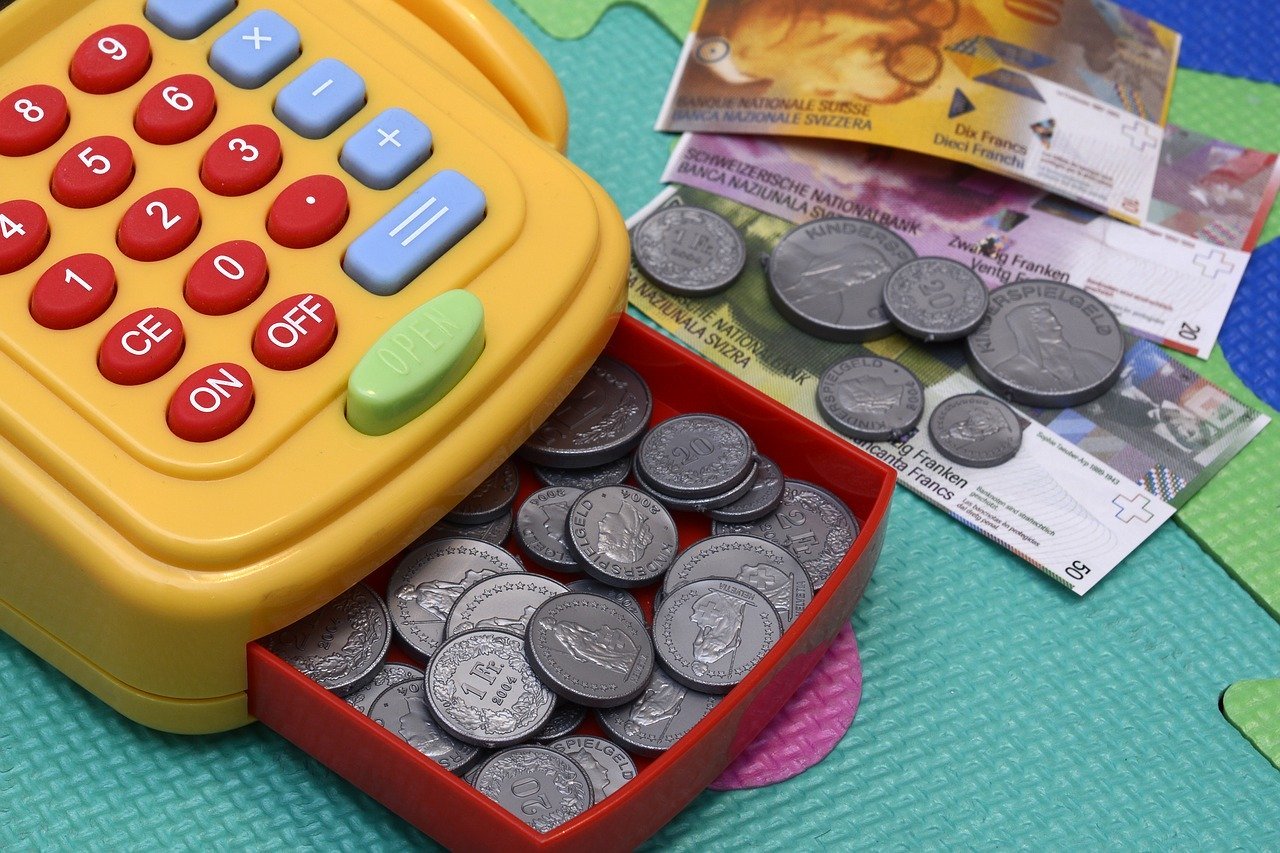Parents must learn how to teach kids about money. By starting young and introducing new topics over the years, you’re setting your children up for success.
Basic money-management skills, proper attitude, and respect for money are important because it will shape their perspective on money and spending as they age.
Here are ten tips for each age ranging from toddlers to college-age that will help get your children off on the right foot.
Toddlers/School-Age Children

Learning how to teach kids about money doesn’t wait until they get their first job. You can start as young as two years old by introducing the basic concepts of money, so they understand what it is and what it’s for.
1. Begin Introducing Money
Whether you use a learning toy, tool, or real money – you can start introducing the concept of money at a young age. Teach your children the difference between coins and paper money and help them understand why we need money and how it benefits us.
At the toddler age, it’s important to teach them what happens when you spend all your money. Explain that money doesn’t come back once you give it away, and that’s why you need to be careful where you spend it.
RELATED: What Do Americans Spend the Most Money On?
2. Play Pretend Store
Playing store is a great and fun way to teach kids about money. Set up a makeshift store with a cash register and a few products to offer. This strategy teaches children about offering products and services in exchange for money.
By playing pretend store, you’re teaching children that you need to offer something if you expect to receive money. Even at a young age, they will begin to associate money with value and understand that if you want to earn money – you need to have something to offer someone.
Here is also a good time to introduce your kids to “making change” and explaining how you get money back even when you give some.
3. Play Pretend Restaurant
While this is very like playing pretend store, restaurants are a little different, and it’s important that you spend this valuable time with your children. By teaching them how a restaurant runs, you’re explaining the correlation between services and money as compared to products.
You can teach kids about the importance of doing a good job when someone is paying you for something. Now is also a good time to start explaining what “tipping” is and why we do it.
While other children may think they can get right up and walk away when they finish their meal at the restaurant, your kids will understand that they need to wait because you haven’t paid for the meal yet.
4. Clip Coupons Together
Couponing is a great way to spend time with your kids while also teaching them the importance of stretching every dollar. Break out the safety scissors, print out some coupons, and spread everything out on the dining room table.
While you’re cutting coupons, explain why you’re doing it and how it benefits the family. If you find a way to save two dollars on a product, explain to your children why those two dollars are important and how it can add up over time.
It’s also a great time to tell them why people can receive reductions on prices and help them understand what a “sale” is and why they should look out for them. Couponing is a great way to help yourself save some money while teaching your kids about it as well. If you’ve never couponed before, now might be a great time to start.
5. Help Him/Her Understand How You Earn Money
There are few lessons more important than teaching your kids about how they earn money, how the cycle of money works, and why they need to understand it. You can start teaching your kids this as young as two or three years old because they’re always watching what you do and paying attention to it.
Why not explain what you’re doing when you go to work and why you’re doing it?
Explain to your children that providing goods and services in exchange for payment is how you’re able to buy toys and snacks for them. Ask them questions about where they think money comes from and how they think people get it?
Now would also be a good time to explain why some people have more money than others. Let your children grow up with a proper understanding of money and how it correlates with the goods and services you provide to the economy.
6. Take Children to the Bank
What better way to show your kids what money is all about than taking them to the bank and explaining what the place is? Teach them about each job at the bank and why they’re important. Explain what an ATM is and why we use it to transfer money in and out of our bank accounts.
When you go to the bank to deposit or withdraw money, explain what each of those words means and why they’re essential to understanding money. Learning how to teach kids about money doesn’t require a ton of knowledge on your end; instead, it’s about creating awareness and understanding of what money is and why we use it.
7. Define Needs vs. Wants
This lesson is critically important to a child because it will help shape their spending habits as they age. We need to teach our children the difference between what we need and what we want. While some kids receive more of their “wants,” they may not always receive as much of their needs.
One of the best things you can do is tell them why they can’t get a certain toy right now and why they may need to wait until their birthday or a special occasion. Whether you can afford it or not, you mustn’t always give in to their wants because it will teach them that it’s okay to wait for something.
Now is also a good time to teach them that it’s okay not to have everything that other kids have. Some kids have more toys than others, but that doesn’t mean they’re happier or any better than you.
8. Start Collecting Coins
Head on over to the US Mint site and buy a coin collecting board or something similar. The site has a ton of resources to help you teach your kids about money and coins while making it fun instead of boring.
Collecting coins is a great way to program your children to keep the money rather than give it all away as soon as they get it. They’ll start to understand the value of saving money and why we need to keep more than we get.
9. Let Your Child Shop
One of the smartest things we can do for our children is to help them understand how much money things cost at a young age. Keep in mind that no matter how much money you have, everything still costs the same. Some kids might look at a 100 dollar bill and think that’s a lot of money. Others will not feel that way.
The best way to level the playing field is to take your kids shopping and show them how much everything costs. Give them a calculator or a pen and paper and let them mark down each time you put something in the cart. Have them add it up as you go along so they can see how expensive food, clothes, and home supplies are.
While you’re doing this, be sure to drive home the “needs vs. wants” point. While they might want a specific toy, explain that you’re not there for toys, you’re there for food because you need food.
10. Discuss Large Purchases
Besides regular trips to the grocery and department store, involve your children in your large purchases and explain to them why you bought that and how much it costs. Many parents are afraid to be transparent with their kids about money because they don’t want them to feel like a burden, but it will help them later on in life.
If you’re purchasing a new vehicle, a new TV, or a pool for your yard – explain how much that costs, how you plan to buy it, and why it costs so much. If you’re purchasing something on credit, it would be a great time to introduce that.
Pre-Teens / Teenagers

As your children age to 11,12 and older, it’s time to start introducing more complex concepts of money. You’ve now set them up with the essential foundation they need to understand money at a basic level. Here is where you can start to teach them about earning money, managing it, keeping it, and spending it responsibly.
1. Discuss Opportunity Cost
Opportunity cost refers to the “cost” of a poor money management decision. For example, you can teach your children about the importance of opening a savings account and collecting interest on that money instead of keeping it in cash or spending it.
Now is also a great time to explain the options of accumulating interest to help them understand why people invest money in certain places. Opportunity cost also means so much more than money.
It can mean the difference between staying at home and studying versus going out with their friends and playing. The cost is the knowledge and opportunity lost as a result of the poor decision.
2. Motivate Kids to Earn Money
A big part of teaching your children about money helps them understand why it’s important to put yourself out there and find ways to make money. A great way to get them motivated is by starting lemonade stands, having bake sales, and involving them in yard/garage sales.
Help teach your children how to make money and why making money should be exciting. Provide them with a goal and ensure that they reach that goal. Once they do, offer a reward in exchange for their hard work.
By doing this, you’re setting a precedent that says, “if you work hard and put effort into something, the reward far outweighs the upfront work.”
3. Teach Them How to Open a Bank Account
When your kids are finally out there earning some money, it would be a good time to help them open a bank account and involve them in the process. They’re likely too young to do it on their own, so you’ll have to open the account for them, but you can explain how you do it and why it’s important.
Be sure to teach them how to deposit and withdraw money, how to use a debit card, the importance of keeping everything secure, and how to collect interest on the money you’re saving.
4. Explain The Importance of Establishing Credit
Credit is something that schools don’t talk enough about, and it’s up to the parents to teach it to their kids. Many young adults find themselves in a troubling position when they get older, and they need to make a large purchase. They’re in this position because no one ever taught them about establishing good credit.
Teach your kids why it’s important to pay bills on time, never fall behind, and always use credit cards wisely. You must teach your children that they can only use a credit card for something they can buy on their own. Cards can offer ways to save for families, and you can teach them that effectively.
Now is the time to teach them about interest rates and why they should look for low interest and manage credit with high interest.
By teaching them, you’re enabling them to look at a credit card offer when they start coming and understand the interest rate and the potential consequence of leaving an outstanding balance on that card after the due date. This will help them understand how to utilize their first credit cards as teenagers or when they apply for credit cards when they are college students.
5. Help with Balancing Checkbooks
Another area of money management that schools don’t cover enough is balancing checkbooks. While there are many budgeting apps and most banking happens online, it’s still important to teach them the basics of debits and credits the old fashioned way.
When your kids start to earn their own money, they need to understand how to make that money last. Most kids won’t have any expenses, so all their money goes towards things they want. They need to know that if they spend all their money, there won’t be anything left over.
6. Show Them How to Develop a Budget
This tip goes hand-in-hand with balancing checkbooks. At the same time, it’s important for them to understand how to add and subtract money from their accounts. They also need to know how to ensure there is money left over after they spend it on what they want.
If you have a teenager, they may have a car that they’re responsible for fueling up and paying for insurance. Once they start establishing some bills, it’s time to teach them how to budget and ensure they always have money to pay for those bills.
Using an app is helpful, but we still believe it’s important for them to look at their account and try to keep as much of the money as possible. Explain why that’s the case. Teach them about preparing for the future and why they’ll want to have money for when they go to college or enter the workforce.
7. Help with Negotiating
Negotiation is a critical life skill that will help stretch the dollar much further. While you can’t negotiate everything, most people don’t realize that many of the things we buy are negotiable. Teach your kids about discussing prices on things like appliances, furniture, vehicles, and used products.
Be sure your teenagers understand that paying the ticket price on an item is not always required, and there is always room to negotiate that price down. While doing this, help them to understand how lowering the ticket price of an item benefits them.
While you’re negotiating prices, you can then take that reduced price and save it. For example, if you negotiate the price of a washing machine from $250 to $200, you can now take that $50 and put it in the bank.
8. Buy Used and Save the Difference
Some people are big believers in buying new everything, but a great way to save money is by purchasing used products. Better yet, a great motto to implement in life is “buy used and save the difference.” The more money you can save on a product, the better off you’ll be.
Teach your teenagers why it’s important always to stretch the dollar and get the most for the money you spend. Correlate these decisions with a goal or accomplishment in the life of your child.
Maybe they’re saving up for a car, but they want to spend $200 on new clothes. Instead, they could go to a thrift store and spend $50 on clothes. The kids can then take that $150 in savings and put it towards their car fund.
9. Talk about Donations and Tax Benefits
Kids are never too young to learn about tax write-offs and why they’re important. Better yet, use this as an opportunity to teach your children about donating to charities and how you can help someone else while helping yourself a little as well.
Teach your kids about the different charities and help them find one that’s near and dear to their hearts. Help them find one they’re passionate about and consider donating some of your own money to it.
Once you’ve done that, teach them about tax write-offs and how that can benefit you, come tax season.
10. Teach the Correlation and Dissociation of Money and Happiness
One of the most important things you can do for your kids when they’re starting to get older into their teenage years is to teach them about money versus happiness. Many kids grow up seeing that other children have more things than them, and they immediately associate that with happiness.
While they might be old enough to understand that they can’t have everything they want, they need to understand that money isn’t everything. Teach your kids that they should chase their passions in life and not worry about the money.
Society often programs us to think that money is bad and evil, but it’s also important to teach your kids about the fact that money gives you options in life, but it doesn’t always make you happy.
Young Adults/College Age

You’ve started your kids off on the right foot, and now they’re young adults or college-age adults. Perhaps you didn’t teach them anything about money, and you’re just starting now, that’s okay too. It’s never too late, but now it’s time to teach them about properly managing larger quantities of money and how to prepare for their future outside of the nest.
1. Develop a Savings Plan
We’ve talked about savings, but now it’s time to put concrete processes in place. Help your young adult put together a savings plan that sets them up for success when they decide to settle down, buy a home, and have a family.
By starting them when they’re in high school or college, you’re establishing a process that they’ll keep with them as they get older. This will help them save more money, but it will also ensure that they have the knowledge needed to manage their money as they start to make more.
A significant problem that a lot of young adults run into after college is “over-spending.” They get their first real job, and they’re bringing in more money than they ever have. Now they start to spend all their money on things that they couldn’t afford before.
They should immediately understand that they need to prepare for their future rather than think so much about the present.
2. Explain Taxes
Gone are the days of using TurboTax and having your aunt do your taxes for you. Your young adult might be making a decent amount of money now, so they need a professional to take care of their taxes for them. Help them through the process by explaining why we pay taxes, what we’re paying for, and how to get them correctly processed.
If your college-age child is self-employed, be sure they understand the need to put a percentage of their income aside to save for taxes. Help them to pay their taxes quarterly, so they’re always prepared and ensure that they do everything legally and safely.
3. Teach Them to Use Budgeting Apps/Programs
As your kids become more independent, you won’t be able to watch over them all the time and see what they’re doing with their money. Now is a great time to help them by recommending some budgeting apps or programs that help them see where they’re spending their money and how they can lower costs and save more.
Be sure to teach them about being responsible and smart with their personal information, so they don’t find themselves in a dangerous or fraudulent situation.
4. Use Experience to Stretch the Dollar
You as the parent have something that they’ll never have, and that’s experience. Use it to your advantage and help teach them different ways you’ve learned to stretch the dollar over time. Every family has a few kept secrets that they used when they needed to, and you should always share those with your kids.
For example, if you shopped at a specific grocery store during a certain time of the year because they had sales, tell that to your young adult kids. Maybe you know of a certain app that helps you get cashback on credit card purchases, talk to them about that, and be open and transparent.
We realize that college-age kids don’t always want to listen to their parents, but if you’ve followed a lot of the tips in this article, chances are you set them up with the proper foundational education that makes them want to learn more about saving money and properly managing it.
If you’ve done that, they’re likely more open than a lot of kids to learning everything they can about money management.
5. Discuss Past Mistakes
Besides your applicable experience, you also have mistakes. Every adult has instances where they made a poor financial decision that resulted in them losing some money or spending more than they should have.
Now could also be a time to explain certain “money pits” or things that you can do in your life that will always take your money away.
For example, suppose you went to a casino for your 30th birthday and lost $10,000. In that case, you can use that experience to teach your kids about being careful at casinos and always setting a maximum amount that you’ll spend before walking away.
Teach them about the importance of being careful with alcohol because you might be more likely to impulse buy when you’re drinking.
6. Explain the Process of Acquiring Mortgage/Home Loan
As they continue to get older, it’s time to get down to serious business and talk to your kids about their first major life purchase. By this point, they’ve likely purchased a car, so they have a general understanding of buying something big on credit, but you want to go in-depth to help them understand the importance of homeownership and why so many people seek to achieve this goal.
Teach your kids how to apply for a pre-approval, how to get a mortgage, how to shop for a house, choosing a realtor, buying in the right area, comparing houses to others in the neighborhood, etc.
All these factors are important when buying a house, and teaching your young adult these lessons will help set them up for success.
7. Talk About Repayment of Student Loans
Before buying a car and a house, the biggest loan your kids might have is their student loans. When you’re going to college, worrying about classes, and trying to get your degree – it’s easy to forget about the dollar signs that are adding up every time you enter that classroom.
That is until they graduate, and they have to start paying the loans back. For many, this is an opportunity to start building credit the right way because on-time payments on your student loans are the perfect way to set yourself up with a high credit score so you can make other purchases down the road.
Help your young adult set up a payment plan that works for them and see to it that they stick to that plan and never miss a payment. Even one missed payment can stay on your credit report for a few years and make it more difficult for you to get the score up to a healthy range.
8. Create a Five and Ten Year Financial Plan
Whether your kid is entering the workforce or going through college, there comes a time when you need to sit them down and talk about their future goals. What are they looking to accomplish? What do they plan to do for the next five or ten years?
You can help walk your kids through a five year plan. If they’re attending college, that might make up most of their plan. They’ll want to focus on their schooling and try not to go broke during the process.
If your kid is entering the workforce, they might be able to start saving some money and establishing credit.
Either way, it’s never too early or too late to get them financially responsible, and you, as the parent, hold a lot of responsibility for ensuring that your children are ready when they enter adulthood.
9. Explain Types of Insurances and their Importance
There comes a time when we need to acquire things that we wish we didn’t have to pay for every month. Some of these things are insurance. Now, if your kid is still living at home with you, chances are you can cover them on your health insurance and motor vehicle insurance until they’re 26. The same applies if they’re residing in a college dorm.
Once your kid moves out of the home, they’ll need to get their own health insurance, car insurance, and even renters insurance if they’re renting their own place. It’s also never too early to start talking about life insurance and at least explaining what it is and how to get it for when they start a family.
It’s said that only about 60% of Americans have life insurance and some don’t have it because they don’t understand what it is and why they need it.
Make sure to help your children understand the different policies, what they each mean, and how they’ll benefit them or their family down the road. Insurance is hard to understand, so make sure that you know what you’re talking about as well.
10. Cover the Basics of Investing
Once your kids are out of college and entering responsible adulthood, it’s a great time to start teaching them about investing and what you can do with your money.
Gone are the days of collecting interest off a savings account or acquiring a CD and leaving your money sitting for 30 years. These simple and basic investing methods don’t offer the same returns as they did 40 years ago.
Today, things are a bit more complicated, and you might not even know as much as you’d like. Your kids must know about 401Ks, pensions, IRAs, and CDs. Explain the difference between each of these, and you could even purchase them a book and go through it with them if you don’t feel confident enough to teach them yourself.
While most of us like to wait a long time to think about retirement, the earlier you start, the better. You can motivate your kid by telling them that they’re not only preparing for retirement, but they’re preparing for the rest of their life. The earlier they start, the earlier they’ll be able to see a large chunk of change accumulating in their accounts.

Recap: Five Most Important Things
- Be transparent
- Opportunity cost
- Explain credit
- Develop budgets
- Investing/Insurance
Learning how to teach kids about money isn’t easy for parents because there are so many things to cover. We covered 30 different tips in this guide for kids and young adults of all ages. Let’s take a quick moment and recap Five of the most important tips to take away from this guide.
1. Be Transparent
One of the trends of each tip, especially for younger children, is transparency about money. You don’t need to be secretive about how much things cost and how much money you have. Help your child understand why they can’t have something and explain that it costs too much. They’ll grow up with a better understanding of how to keep the money rather than spend it all.
2. Opportunity Cost
Opportunity cost is something that many people don’t want to talk about, but everyone must understand what this means when growing up. It applies to all aspects of life and not just money. By making the right choices in life, you can reap the rewards of those choices, even if they’re not the most “fun” or enjoyable.
3. Explain Credit
There are few things more important in this world than establishing good credit. Having a high credit score out of the gate will enable your kids to make large purchases and have a bit of leverage when negotiating prices. By having good credit and buying at the best price, they’re setting themselves up for years of financial success.
4. Developing Budgets
It’s never too early to establish a budget and learn how to stick to one. By teaching your kids young, you’re showing them that it’s important to be responsible with money and have respect for it. As soon as your kids have a job where they’re making more than a few bucks a week, you should help them put together a budget.
5. Investing/Insurance
Many parents never teach their kids about these two things, and it causes confusion and error down the road.
When you don’t teach your kids about how to look for the right insurance or investments, they’re left to fend for themselves in a sea of sharks. Salespeople will then be the ones responsible for teaching your kids about what is right for them, and you know what happens next. They get taken advantage of and end up in a bad deal.
Wrapping Up
With the costs of goods and services rising, it’s more and more important that we learn how to stretch the dollar as far as possible. Teaching your kids about money from a young age is a great way to help set them off on the right foot so they can continue to practice good financial responsibility as they get older.
Remember that you can teach any kid of any age something about money. If they’re a toddler, it’s as simple as showing them money and teaching them about it.
If they’re a school-age child, you can take them to the store, show them how much things costs and give them opportunities to work for money.
Once they become young adults you can introduce them to more complex concepts of money that will help prepare them for decades of financial responsibility.
What’s most important is the transparency around money and the fact that you share your family’s financial situation with your kids; not to scare them or concern them, but to be open and honest so they understand what life is like and how important it is to be responsible with your money.
